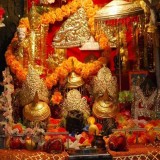Vaishno Devi, also known as Mata Rani, Trikuta and Vaishnavi, is a manifestation of the Hindu Mother Goddess Mahalakshmi. The words "maa" and "mata" are commonly used in India for "mother", and thus are often used in connection with Vaishno Devi.
The holiest Hindu temples dedicated to adi Shakti, situated in the hills of Katra in Jammu and Kashmir. Vaishno Devi temple is second most visited religious place in India after the world famous Tirumala Venkateswara Temple. Maa Vaishno Devi shrine also known as Mata Rani is located at an altitude of 5300 feet is a manifestation of the Mother Goddess Durga.
From high up in the mountains Mata Vaishno Devi calls out to her devotees… Situated on the Trikuta Hills in Jammu, the abode of Mata Vaishno is amongst the most popular pilgrimage in India. Experience an indescribable delight in taking an arduous trek that further leads to the caves where the goddess presides over and bestows countless blessings. Beautiful landscape, pervading divinity and thrilling adventure…this is one journey in India that will remain etched in your memories forever.
Like with most old Shrines, it is not possible to ascertain when exactly the pilgrimage to the Holy Shrine started. A geological study of the Holy Cave has indicated its age to be nearly a million years. Vedic literature gives no reference to the worship of any female deity, although the mountain Trikuta does find its mention in Rigveda, the oldest of the four Vedas The practice of worshipping Shakti, largely started in the Puranic period.
The first mention of the Mother Goddess is in the epic Mahabharat. When the armies of Pandavs and Kaurvas were arrayed in the battlefield of Kurukshetra, Arjun, the chief warrior of Pandavs upon advice of Sri Krishna; meditated upon the Mother Goddess and sought Her blessings for victory. This is when Arjun addresses the Mother Goddess as ‘Jambookatak Chityaishu Nityam Sannihitalaye’, which means ‘you who always dwell in the temple on the slope of the mountain in Jamboo’ (probably referring to the present day Jammu).
It is also generally believed that the Pandavs were the first to build the temples at Kol Kandoli and Bhawan in reverence and gratitude for the Mother Goddess. On a mountain, just adjacent to the Trikuta Mountain and overlooking the Holy Cave are five stone structures, which are believed to be the rock symbols of the five Pandavs.
Perhaps the oldest reference of the visit of a historical figure to the Holy Cave is that of Guru Gobind Singh who is said to have gone there via Purmandal. The old foot track to the Holy Cave passed through this well-known pilgrimage centre.
Some traditions believe this Shrine to be the holiest of all Shaktipeeths (a place where the Mother Goddess, the Eternal Energy has Her abode) since the skull of Mata Sati fell here. Others believe that her right arm had fallen here. But some scriptures do not agree with it. They do agree that at a place called Gandarbal in Kashmir, the right arm of Sati had fallen. Nevertheless, in the Holy Cave of Shri Mata Vaishno Deviji, one does find stone remains of a human hand, popularly known as Varad Hast (the hand that grants boons and blessings).
About Shri Mata Vaishno Devi
History


